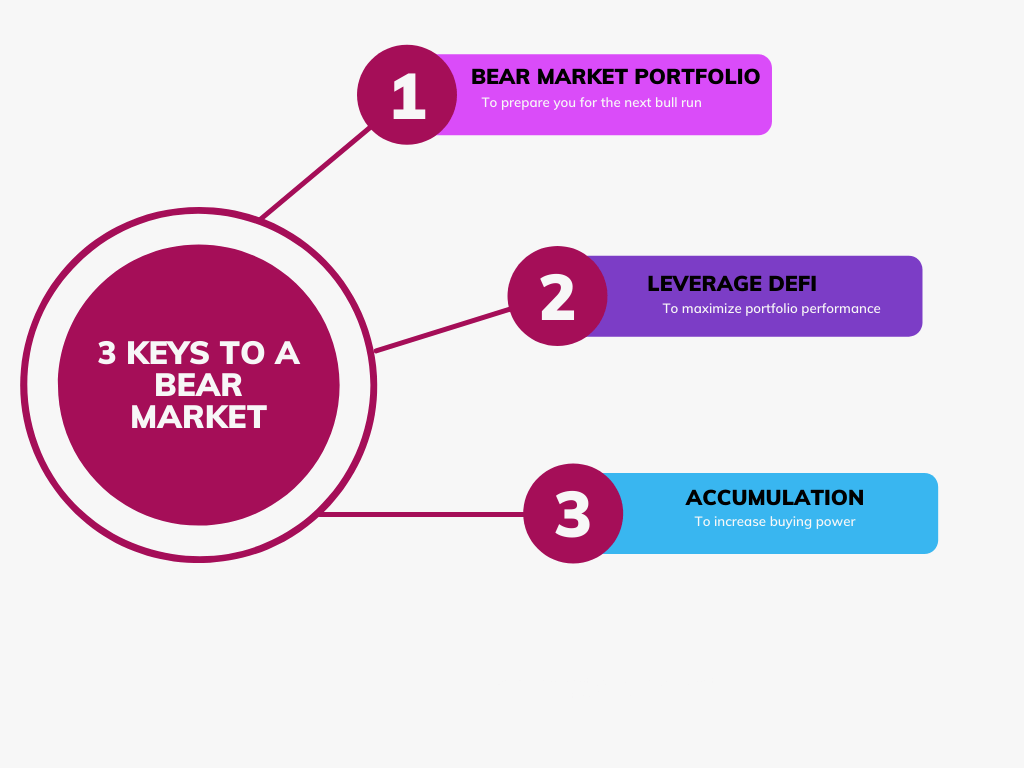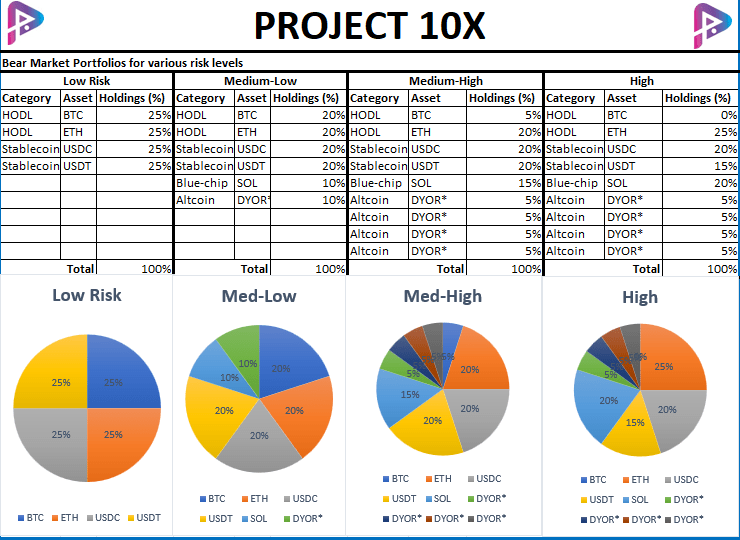The truth is, generational wealth is created in bear markets, not bull markets, as some would have you believe.
Crypto “influencers”, Crypto Twitter (CT) accounts, and YouTubers (YT’ers) will tell you to “buy the dip”, but this advice is not reasonable nor actionable. Where we are in the market is critical to understanding how to “play the market”. We are currently in a bear market.
Those that made life-changing money in 2020/2021 did so because between 2018 and 2020, they were doing the research, accumulating, studying trends, and positioning themselves for what was to come.
Figure 1
Here we will cover the three (3) most important things to position yourself in a bear market to maximize the chances of life-changing returns in the next bull run. Our team readily implements this, and we cover these in more detail in our workshops.
- Building a winning bear market portfolio to set you up for the bull market.
- Leveraging DeFi to maximize your portfolio’s performance
- Accumulation strategy
Your sole focus should be on learning, accumulating, and surviving in a bear market. Speculating on micro-cap altcoins in a clear downtrend can only end one way (for most people) and is akin to catching a falling knife. There is no path to generational wealth if you buy micro-caps, shitcoins, and other illiquid projects (NFTs) that continue to bleed out for the next two years. The crypto space will break All-Time-Highs (ATHs) again. Still, many projects will remain remnants in the ever-growing crypto graveyard, never to be thought of again. That’s why it’s essential to position yourself correctly.
Here are some bear market portfolio examples depending on your risk appetite.
Figure 2
This is a sample portfolio, and the digital assets therein are interchangeable. However, your focus should be on having a portfolio that mitigates downside risk and aligns with your risk tolerance. What’s the best way to reduce downside risk in a bear market? Stablecoins! Second best way? Blue-chip assets!
Your risk tolerance is defined by
- Your financial goals – 1k to 100k? 100k to 1M? 1M to 2M?
- Crypto exposure – Are you comfortable having 5%, 20%, 50%, 70%, 100% of your net worth in this asset or asset class?
- Personal conviction – you not only believe in the project, but you also have clear and actionable insights that will almost certainly result in a positive return
Regardless of your risk tolerance, the universal takeaway is that you should always have a sizeable stablecoin position. How?
Grow your stablecoin portfolio using the following strategies:
- Taking profits on holdings during bear market pumps
- Farming stablecoins
- Staking digital assets from your portfolio
Let’s break down how to execute each of these strategies.
Taking Profits During Pumps
Let’s say you’re a firm believer in what Nexo is doing in the space, and you’ve been accumulating their digital token $NEXO.
The figure below shows that $NEXO (and most other digital assets) have been in a clear downtrend since the market peaked in November 2021. Pay careful attention to the volume bars at the bottom. This is a helpful indicator of market narrative or tailwind effects in play. Since Feb 2022, there has been minimal trading volume compared to the mid-end of 2021.
Figure 3
However, following the world’s biggest exchange listing (Binance) the token, the price has surged +63%. This was a perfect time to take profit on your holdings during a bear market pump. Why?
- The crypto market is in a clear downtrend (Figure 3)
- Volume surged compared to the average trading volume over the last few months (Figure 4)
- Binance listing created a favourable tailwind, and social mentions went through the roof (Figure 5)
Figure 4
Before the listing, the number of daily social mentions was ~100-300. Following the listing, it climbed to 1,860. How did the price react to this? It almost hit ATH (see Figure 3).
Figure 5
Courtesy of @LunarCrush, we can overlay the price on the social mentions. We see that the price surge matched the last three (3) candles to a tee. Peak social mentions = peak price. Falling social mentions = retracement of price.
Figure 6
Bottom line: Take profit on holdings during pumps so that you can replenish your stablecoin holdings or buy back lower.
Pro Tip: If your investment doubles, take your principle out. That way, you are effectively riding risk-free.
Farming Stablecoins
Some of the best stablecoin farming information can be found on @Coindix. You can filter for stablecoins only and sort by Annual Percentage Yield (APY). For farming, our approach is simple. The majority of stablecoins are in farms with high TVL. This is a great strategy for passive income and to keep topping up your stablecoin reserves.
More advanced users can check out
- @BeefyFinance USDC/BUSD/USDT vault ~24%
- @planet_finance aUST vault with looping ~30-40%
- @Bancor USDT with single sided liquidity in the USDT/BNT pool (~28%)
- @beethoven_x USDB/DAI ~38%
Just remember, stablecoins are not entirely risk-free. Here are some inherent risks to consider.
- De-peg Risks: Algorithmic stablecoins can de-peg.
- Regulatory Risks: Stablecoins may be outlawed by governments.
- Operational Risks: Improper or ineffective governance may ultimately make the stablecoin worthless.
Then again, holding cash is also at risk from dollar devaluation and inflation.
Staking Digital Assets from Your Portfolio
There are only a few reasons users should not stake their PoS assets for passive income. With the proper security protections in place and due diligence, it is a relatively simple way to earn an additional yield on your asset of choice, secure the network and rotate into stablecoins during pumps. This isn’t necessary, however, and you can simply hold the underlying asset.
Solo staking is considered the gold standard. Essentially, it is the act of running a node connected to the internet. This method provides full participation rewards, improves a network’s decentralization, and never requires trusting anyone else with your funds.
However, most users will opt for Staking-as-a-Service (StaaS) or pooled staking. This involves delegating node operations to a 3rd party validator for a commission or a cut of your profits. Three (3) things to consider when selecting a validator.
- The validator’s total stake (big isn’t necessarily beautiful!)
- The amount of commission the validator charges in fees
- The overall performance of the validator pool
Let’s use Solana as an example. We can use stakeview.app and validators.app to find high performing validators with low commissions.
The largest validator pool on Solana is @Everstake, with 625,000 users and 12.9M $SOL staked. However, it also charges a 7% commission and has an ~11% skipped vote percentage. The fewer votes skipped, the higher the rewards earned each epoch. The higher the rewards, the greater your own share.
Figure 7
On the other hand, Shinobi Systems (stakeview’s own validator) has a consistently low skipped vote % and commission fee.
Figure 8
This is confirmed on the stakeview.app website along with the estimated APY. Shinobi’s APY is 5.24%.
Figure 9
Everstake APY is 4.36%
You could then build a comparison tool to determine the yield difference between two (2) validators based on these metrics. We’ve created a simple tool below which we freely distribute to our “How to DeFi” workshop attendees.
The data shows a ~40%% difference in staking yields between the largest validator (Everstake) and Shinobi Systems.
Figure 10
Buying the Dip
An excellent time to deploy capital in a bear market is when markets are down significantly.
When heatmaps bleed red such as this one from @Coin360.
Figure 11
When the Bitcoin Fear and Greed Index starts looking like an (empty) petrol indicator on your vehicle.
Figure 12
When we are in a downtrend and an On-Balance-Volume (OBV) indicator is so deep in the red, it has been months or even years since it last hit those levels (see November 2019 and March 2020). There’s more to it than ‘when it is red’, but you get the gist.
Figure 13
When that time comes, it’s equally as important to not deploy your capital all at once. Remember, bear markets are brutal, and as history shows, they can last for years. Instead, use the Dollar-Cost-Average (DCA) method, and what you may find is that not only is
- Your average buy price lower than if you had ape’d in at the first sign of a dip or FOMO’d in at a high; but also
- You won’t feel so terrible if it “keeps dipping” because you’ve still got a significant portion of your portfolio in stablecoins earning yield and can enter at a lower price.
Figure 14
Aside from DeFi plays, earning additional or passive income is critical. Here are some examples:
- FT/PT job or career to deploy salary and bonuses into DeFi, digital assets, equities, and real estate.
- Side-hustle. You don’t have to be the next Gary Vee, but you do have to want it.
- Are you super into Kefir? Great! Get yourself a starter culture and sell the spare grains as it grows.
- Are you into beauty? Perfect. Order some beauty products on Alibaba, set up a webpage, advertise on Gumtree/Craigs List, and get selling.
- Love soccer? Way to go. Now level up by getting your refereeing certificate and refereeing on the weekends. As a bonus, you’ll also be on your way to losing a few kgs!
- Consider yourself a techie and fix your own computers and/or phones? Well done. Now it’s time to advertise your services on service-seeking websites. If you need parts, head on over to Amazon/Alibaba.
Side-hustles/jobs are sure-fire ways to earn additional income and keep you in the game during the often-gruesome bear markets. I know these may seem abstract, but I can assure you they work. Why? Because I’ve done each of them at some point in my life.
Most of all, bear markets are for learning. Upgrade your DeFi skills, learn trading principles, whale watch on the blockchain, learn to write, and learn to code. I could go on, but I think you get the point.
Remember. Take risks. Shoot your shot. Generational wealth is created in bear markets, not bull markets. That’s all for now.
If you’re interested in exploring this further, come along to our “How to DeFi” workshops and learn ‘on the job’.

















